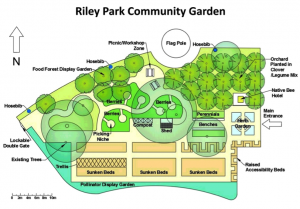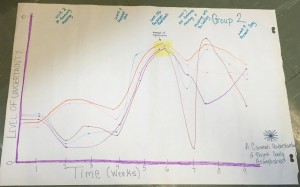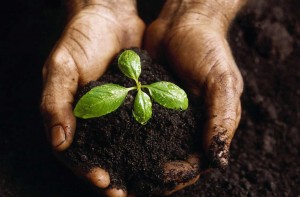Hello! This is our 4th and final blog posting for LFS 350. After these past three months since our project began, we can finally say that we have reached the summit of our project. We have immensely enjoyed this journey, from interacting with our community partner Joanne to engaging with the Little Mountain Riley Park (LMRP) community members.
As we move into the final weeks of the course our project is drawing to a close. Our last item to tackle is our final project report. In this blog post we have included the executive summary from our project report, which we hope gives you some idea of the conclusions we have come to from analyzing our data. We hope that these conclusions may be used to optimize community member access to the LMRP garden (plan pictured below).

Figure 1: LMRP Garden Plan
EXECUTIVE SUMMARY
This project was carried out by a group of five students enrolled in LFS350 in conjunction with the Little Mountain Riley Park (LMRP) Neighbourhood Food Network (NFN). NFNs in Vancouver are a component of the Greenest City 2020 Action Plan, with the goal of ensuring equitable access to health local food, thereby promoting food security (City of Vancouver, 2012). The LMRPNFN is acquiring space in the Fall of 2016 to build an accessible and inclusive community garden (CG) in the LMRP area (Joanne MacKinnon, personal communication, 2016). As the LMRP area is socioeconomically and ethnically diverse, special considerations must be taken to ensure that residents are able to access the garden’s services to the best of their ability (City of Vancouver, 2011; Joanne MacKinnon, personal communication, 2016). The goal of this project was to identify demographic specific barriers to participation in the LMRPCG in order to ensure equitable access to garden services by LMRP community members.
The main objectives of this project were to design, distribute, and analyze data from a survey completed by community members identified as part of populations of particular interest by our community partner, Joanne MacKinnon. These populations included elderly, newcomer, and low-income groups. We utilized a mixed methods approach for this survey, collecting quantitative data through our nine-item survey and qualitative through both speaking with community members and providing some open-ended response questions within the survey. The questions that our survey was answering were as follows:
- What programs based at the community garden would be most beneficial for the elderly, newcomers and low-income populations?
- What potential barriers do the elderly, newcomers and low-income populations of LMRP anticipate to their participations in the community garden?
From analyzing our survey data, community members were most interested in the socialization and learning aspects of the garden, with a notable lack of interest in gardening itself. In terms of demographic specific barriers to participation, language and lack of free time were the most frequently reported. In consideration of our project findings, we suggest the following:
- Continue to focus on the socialization aspect of the garden.
- Provide garden services in Cantonese, Mandarin, and Spanish where possible.
- Keep garden activities and services low or no-cost.
- Offer a shuttle service to and from the garden for participants with accessibility issues.
We hope that our data and suggestions may be used by the LMRPNFN to allow the increased participation of key populations in the LMRP area.
REFLECTION
Throughout the semester, we encountered many roadblocks during our project’s development. Our first major roadblock was the negative feedback we received on our proposal – as students, we found that it was difficult to separate the feedback meant to better our project development from the negative feelings we associated with the grade itself. However, this roadblock allowed us to, as Steven Levitt called, it “fail quicker” (Freakonomics, 2015). With the feedback we received on what we felt was a failure, we were able to move forward with confidence after improving the quality of our report. Our revised project proposal better addressed the “What, How, and Why” of our project, so that our community partner could more fully assess the value and content of our project’s intended trajectory (Valley, 2016a).
Our second major roadblock occurred when we had a scope shift due to feedback from our community partner. Originally, we proposed the creation of workshop selection criteria. These criteria were meant to account for budget, seasonality, utilization, and community needs to optimize workshop selection for the LMRPCG. However, upon reflection it is clear that this project did not put the community members at the forefront of our project development. Based on feedback from our community partner and the LFS 350 teaching team, we collaborated to design a survey that focused on the needs of the key populations mentioned above. By approaching this project with an asset-based community development lens, we were able to interact with the community members and use their knowledge of what they want and needed (Valley, 2016b). This is in stark contrast to our original needs-based approach, where we were coming in as external academics and telling the garden organizers and community members what we thought they needed.
As our project draws to a close, we hope that the data that our project has provided can be a valuable tool for the garden organizers to continue to promote food security. While we have felt confused and lost at points during this project, we ultimately are very glad that we chose this project. It was a pleasure working with Joanne and the LMRP community members. Working directly with community members on the LMRPCG intended to improve community food security has cemented our knowledge surrounding the course goals of LFS 350.
On behalf of the LFS 350 Group 2 team, we would like to say thank you to Joanne MacKinnon and the LMRPCG organizers for this opportunity to work with them.
References
City of Vancouver. (2012). Greenest City 2020 Action Plan. Retrieved from http://vancouver.ca/files/cov/Greenest-city-action-plan.pdf
City of Vancouver. (2011). Census Local Area Profiles 2011. Retrieved from http://data.vancouver.ca/datacatalogue/censusLocalAreaProfiles2011.htm
Freakonomics. (2015). Failure is Your Friend: A Freakonomics Radio Rebroadcast. Retrieved from http://freakonomics.com/podcast/failure-is-your-friend-a-freakonomics-radio-rebroadcast/
Valley, W. (2016a). Session 4 – Crafting a Proposal (Required Readings + Resources). Retrieved from http://lfs350.landfood.ubc.ca/session-notes/term-1-session-notes/session-4/
Valley, W. (2016b). Session 2 – Community Food Security + Asset-Based Community Development (Required Readings + Resources). Retrieved from http://lfs350.landfood.ubc.ca/session-notes/term-1-session-notes/session-2/




